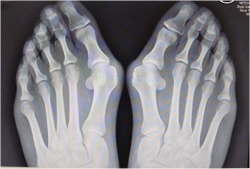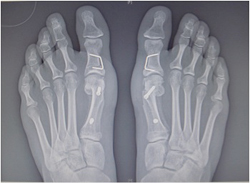Bunions, known medically as Hallux Valgus, are an overgrowth of bone and skin, usually of the big toe, leading to a deformity and skin irritation. Corns are lesions of the skin and are the result of calluses on the skin of the top or bottom of the feet.
As corns and calluses are skin conditions, the treatments are relatively simple and can be carried out at home or at a podiatry clinic. Bunions, on the other hand, require surgical intervention to remove the outgrowth and completely stop any pain resulting from the deformity. Bunion surgery is performed by a Consultant Orthopaedic Foot and Ankle Surgeon or Podiatric Surgeon and involves breaking the toe bone (known as an osteotomy) and cutting the deformed tendon and bone; this is re-set using a small screw. Below are pictures of bunions before and after surgery performed by totalhealth consultant, Mr Sam Singh.


If you are unsure whether you have a bunion or a corn your GP can diagnose the problem for you and suggest the treatment option that is right for you. If you would like to contact Mr Sam Singh to discuss bunion removal options please click here.







